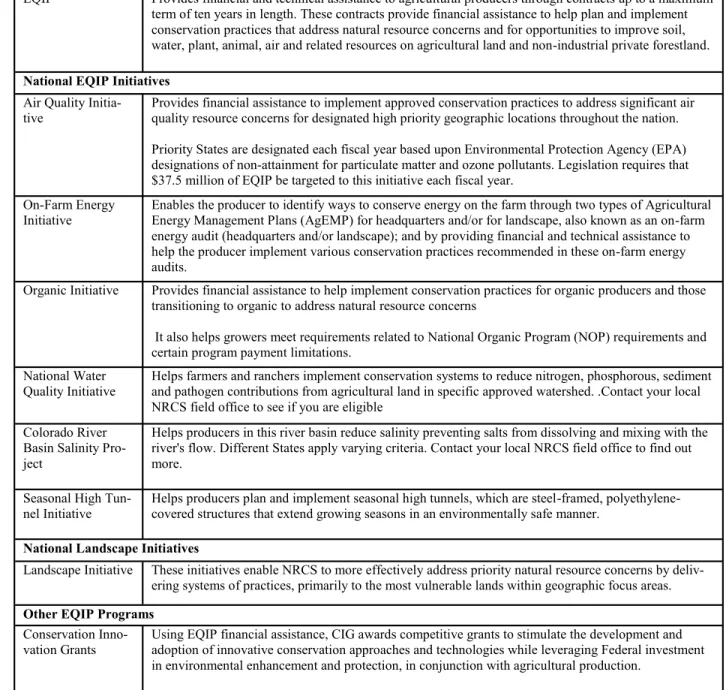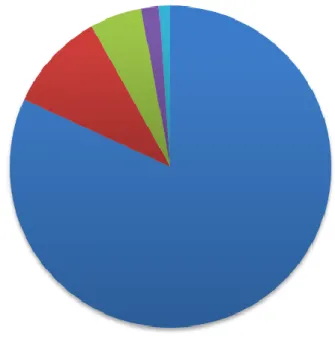Department of Agricultural and Resource Economics, Fort Collins, CO 80523-1172
http://dare.agsci.colostate.edu/outreach
The working land conservation programs of 2008, the
Conservation Stewardship Program (CSP) and the
Environmental Quality Incentives Program (EQIP),
will experience a somewhat increased role in the 2014
Farm Bill, due to the sun-setting of other programs.
These programs are targeted to land that has the
highest conservation benefits which are usually, but
not necessarily, on smaller farms (USDA OBPA
2014). This brief takes a closer look at EQIP.
What is EQIP?
The EQIP program is designed to help agricultural
producers and non-industrial forestland owners meet
environmental standards set by the Federal, State,
Tribal and local governments by providing financial
and technical assistance on select projects. Financial
assistance is available for conservation practices that
address natural resource issues including the
improve-ment of soil, water, plant, animal, or air resources.
Contracts that provide financial assistance may be up
to ten years in length (USDA NRCS, 2014).
In Colorado, EQIP saw a steady budgetary increase
from 1995 to 2009, the last year data are available. It
grew from less than $1 million in 1996 to a peak
of over $27 million in 2008. After 2008 the EQIP
program in Colorado declined somewhat, falling to
under $24 million in 2009. The regular EQIP program
has made up over 80 percent of program payments
since 1995, followed by the ground and surface water
initiatives at just under 10 percent (Figure 2) (USDA
NRCS, 2014).
What is different for 2014?
The Environmental Quality Incentives Program is
ex-tended through FY2018 by the 2014 Farm Bill
repre-senting a continuation of its objectives. However,
EQIP undergoes several fundamental changes. First, it
is expanded to incorporate the functions and funding of
the Wildlife Habitat Incentives Program (WHIP),
which has been eliminated in the 2014 legislation.
Sec-ond, the functions of the Agricultural Water
Enhance-ment Program, which was previously a part of EQIP,
are now a part of the newly created Regional
Conser-vation Partnership Program.
As the second working lands program extended under
Title II by the 2014 Farm Bill, EQIP is designed to
encourage producers to install and maintain
The Agricultural Act of 2014: Working Lands Programs, The Environmental Quality Incentives
Program (EQIP)
Daniel Villar and Andrew F. Seidl
1June 2014
ARPR 14-06
Figure 1: EQIP Program Descriptions
Source: USDA Natural Resources Conservation Service, 2014
There are several EQIP initiatives:
Program Name Program Description
EQIP Provides financial and technical assistance to agricultural producers through contracts up to a maximum term of ten years in length. These contracts provide financial assistance to help plan and implement conservation practices that address natural resource concerns and for opportunities to improve soil, water, plant, animal, air and related resources on agricultural land and non-industrial private forestland.
National EQIP Initiatives
Air Quality Initia-tive
Provides financial assistance to implement approved conservation practices to address significant air quality resource concerns for designated high priority geographic locations throughout the nation. Priority States are designated each fiscal year based upon Environmental Protection Agency (EPA) designations of non-attainment for particulate matter and ozone pollutants. Legislation requires that $37.5 million of EQIP be targeted to this initiative each fiscal year.
On-Farm Energy
Initiative Enables the producer to identify ways to conserve energy on the farm through two types of Agricultural Energy Management Plans (AgEMP) for headquarters and/or for landscape, also known as an on-farm energy audit (headquarters and/or landscape); and by providing financial and technical assistance to help the producer implement various conservation practices recommended in these on-farm energy audits.
Organic Initiative Provides financial assistance to help implement conservation practices for organic producers and those transitioning to organic to address natural resource concerns
It also helps growers meet requirements related to National Organic Program (NOP) requirements and certain program payment limitations.
National Water Quality Initiative
Helps farmers and ranchers implement conservation systems to reduce nitrogen, phosphorous, sediment and pathogen contributions from agricultural land in specific approved watershed. .Contact your local NRCS field office to see if you are eligible
Colorado River Basin Salinity Pro-ject
Helps producers in this river basin reduce salinity preventing salts from dissolving and mixing with the river's flow. Different States apply varying criteria. Contact your local NRCS field office to find out more.
Seasonal High
Tun-nel Initiative Helps producers plan and implement seasonal high tunnels, which are steel-framed, polyethylene-covered structures that extend growing seasons in an environmentally safe manner.
National Landscape Initiatives
Landscape Initiative These initiatives enable NRCS to more effectively address priority natural resource concerns by deliv-ering systems of practices, primarily to the most vulnerable lands within geographic focus areas.
Other EQIP Programs
Conservation
Inno-vation Grants Using EQIP financial assistance, CIG awards competitive grants to stimulate the development and adoption of innovative conservation approaches and technologies while leveraging Federal investment in environmental enhancement and protection, in conjunction with agricultural production.
conservation practices on agricultural and grazing
lands, wetlands, forested lands, and wildlife habitat that
address soil, water and related natural resource impacts
by providing financial assistance to eligible farmers
(USDA OBPA 2014). Additionally, EQIP takes on the
responsibility of providing funding for wildlife habitat
development previously found under the Wildlife
Habi-tat Incentive Program (WHIP). The purpose of WHIP
was to encourage voluntary habitat conservation and
rehabilitation on agricultural lands. In order to maintain
adequate protection of wildlife habitat with the
retire-ment of WHIP, at least 7.5% of EQIP funds must be
targeted to these activities
(CBO 2014)
.
How do I enroll?
Individuals or entities with an Adjusted Gross Income
of $1 million per year or less who are engaged in
live-stock, agricultural or forest production may be eligible
to receive EQIP funding for natural resource
conserva-producers, tribes, beginning or limited resource farmers
and ranchers and other historically underserved
produc-ers may be eligible for advanced and increased
pay-ments. The typical limit for aggregate payments is
$300,000. Projects that have special environmental
significance may be eligible for an additional $150,000
(USDA NRCS, 2014).
Funding may also be available to assist in developing
conservation plans required for EQIP projects. The
National Resources Conservation Service (NRCS) will
work with producers to develop and implement
conser-vation plans. Plans must identify a specific natural
re-source concerns and conservation practices needed to
address the issue. Applications to EQIP can be
completed at a local NRCS field office. Applications
may have a submission deadline or be subject to
rank-ing; however, applications are accepted on a rolling
basis.
Figure 2: Historical Spending on EQIP in Colorado, 1999-2012 Source: Environmental Working Group, 2014
Summary of changes to EQIP:
Prior Law/Policy Enacted 2014 Farm Bill (P.L. 113-79)
Authorizes EQIP, stating its purpose as promoting production and environmental quality as compatible goals, and optimizing environmental benefits by assisting producers: (1) with com-pliance with national regulatory requirements; (2) to avoid the need for regulation; (3) to install and maintain conservation practices; (4) to make cost-effective changes to current pro-duction systems, and (5) to reduce administrative burdens by consolidating planning and regulatory compliance.
Removes the 5th purpose area that requires the reduction of administrative burdens on the producer through consolidat-ing conservation plannconsolidat-ing and streamlinconsolidat-ing regulatory com-pliance processes. Adds wildlife habitat improvement and development practices to the 3rd purpose area.
Defines six terms: eligible land, National Organic Program,
organic system plan, payment, practice, and program. Incorporates the definition of the National Organic Program into the definition of an organic system plan. Authorizes EQIP through FY2014. Contracts are 1-10 years in
length. Reauthorizes EQIP through FY2018. Removes the minimum one-year contract length requirement. Limits EQIP payments to not more than 75% of the cost (up to
90% for limited resource, socially disadvantaged farm or rancher, or a beginning farmer or rancher) and not more than 100% of income forgone. Greater significance is provided for determining income forgone payments for specific manage-ment practices. Advance paymanage-ments for certain producers are limited to 30% of the cost-share rate.
Revises the list of practices afforded greater significance when determining income forgone. Adds veteran farmer or rancher to the list of certain producers eligible for higher cost -share rates. Increases the limit for advanced payments to certain producers to 50%.
Requires that 60% of EQIP payments go to practices related to livestock production requirement between FY2008-FY2013.
Extends through FY2018 the requirement that 60% of pay-ments be for livestock production. A minimum of 5% of funds go to payments benefiting wildlife habitat. Authorizes the Wildlife Habitat Incentives Program (WHIP),
providing cost-sharing to landowners who improve habitat. Authorized to receive mandatory funding of $85 million annu-ally through FY2013.
Adds a new provision under EQIP specifically for wildlife habitat incentive practices. Language is similar to the Wild-life Habitat Incentives Program, which is repealed. Requires the Secretary to consult with State Technical Committees once a year when determining eligible practices.
Identifies priorities to program applications. Gives higher priority for producers using cost effective conservation prac-tices to achieve environmental benefits.
Changes “environmental benefits” to “conservation bene-fits.”
States that in exchange for EQIP payments, producers will not conduct any practices on the farm, ranch, or forest land that could defeat the purpose of the program.
Changes “farm, ranch, or forest” land to “enrolled” land. Limits EQIP participant’s payments to $300,000 for any
six-year period. This may be waived to up to $450,000 for any six -year period if the contract is of environmental significance.
Raises the EQIP payment limit to an aggregate of $450,000 between FY2014- FY2018 and eliminates the waiver authori-ty for contracts of environmental significance.
Authorizes Conservation Innovation Grants (CIG), a competi-tive grant program within EQIP. Grants are provided, on a matching basis, to implement innovative conservation practic-es. Provides $37.5 million of EQIP funds annually (FY2009-FY2013) to address air quality concerns.
Reauthorizes the air quality funding carve out of $25 million of EQIP annually through FY2014. Adds research and demonstration activities, and new technology pilot testing as eligible projects. Adds a reporting requirement that no later than Dec. 31, 2014, and every 2 years thereafter, a report must be submitted to Congress regarding CIG funding, pro-ject results, and technology transfer efforts.
Authorizes mandatory EQIP funding, rising from $1.2 billion in FY2008 to $1.75 billion in FY2014.
Authorizes mandatory EQIP funding: $1.35 billion (FY2014); $1.6 billion (FY2015); $1.65 billion (FY2016-FY2017); and $1.75 billion (FY2018).
Figure 3: Summary of Changes to EQIP Source: Congressional Research Service, 2014

